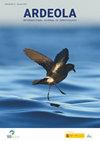红鸢蝇电刑时空格局分析
IF 1.2
4区 生物学
Q2 ORNITHOLOGY
引用次数: 7
摘要
总结。西班牙卡斯蒂亚León地区是红鸢在欧洲最重要的越冬地区之一。同时,那里也是红鸢数量下降最快的地方,电线触电是主要原因之一。因此,了解这种猛禽的年时空生态及其与触电事件的关系,对于制定有效的保护措施是必要的。在考虑气候、地形和土地利用的基础上,建立了Castilla y León红鸢繁殖种群和越冬种群的分布模型,分析了它们之间潜在的空间差异。电刑风险模型还考虑了电线杆的技术特性,以确定它们在两个季节对电刑事件的影响。我们的研究结果显示,两个不同的区域被季节性地使用:1)一个重要的越冬区在该地区的中心,以作物区、温和的温度、垃圾场和人类的存在为特征;2)一个筑巢区在该地区的南部,其中牲畜尸体的可用性、低水平的降水、距离垃圾填埋场的距离和平缓的地形是影响最大的变量。触电风险模型表明,最适合红风筝繁殖的区域也是那些最危险的区域,包括最危险类型的电线杆;有直臂或拱形交叉臂的。最后,本文提出的理论方法为设计管理和控制措施提供了一个框架,旨在最大限度地减少伊比利亚半岛北半部的红风筝触电。-Crespo-Luengo, G., Hernández-Lambraño, r.e., Barbero-Bermejo, I. & Sánchez-Agudo, J.A.(2020)。红鸢猴电刑时空格局分析。中国生物医学工程学报,37(6):447 - 468。本文章由计算机程序翻译,如有差异,请以英文原文为准。
Analysis of Spatio-Temporal Patterns of Red Kite Milvus milvus Electrocution
Summary. The Spanish Castilla y León region is one of the most important wintering areas in Europe for the Red Kite Milvus milvus. At the same time, the steepest population declines of Red Kite have been recorded there, electrocution by power lines being one of the main causes. Thus, knowledge about the annual spatio-temporal ecology of this raptor, and its relationship to electrocution events, is necessary to develop effective conservation measures. Distribution models for the breeding and wintering populations of the Red Kite in Castilla y León were developed, considering climate, topography and land uses, to analyse the potential spatial variation between them. Models for electrocution risk also considered the technical characteristics of the power poles to determine their impact on electrocution events in both seasons. Our results show two different areas are used seasonally: 1) an important wintering area in the centre of the region, characterised by crop zones, moderate temperatures, rubbish dump sites and human presence, and 2) a nesting area in the south of the region, in which the availability of livestock carcasses, low levels of precipitation, distance from landfills and gentle relief were the most influential variables. The electrocution risk model indicates that the most suitable areas for Red Kite reproduction are also those that are most risky, including power poles of the most dangerous types; those with straight or vaulted cross-arms. Finally, the theoretical approach presented here provides a framework for the design of management and control measures aimed at minimising Red Kite electrocutions in the northern half of the Iberian Peninsula. —Crespo-Luengo, G., Hernández-Lambraño, R.E., Barbero-Bermejo, I. & Sánchez-Agudo, J.A. (2020). Analysis of spatio-temporal patterns of Red Kite Milvus milvus electrocution. Ardeola, 67: 247-268.
求助全文
通过发布文献求助,成功后即可免费获取论文全文。
去求助
来源期刊
CiteScore
2.30
自引率
6.20%
发文量
16
审稿时长
>12 weeks
期刊介绍:
Ardeola: International Journal of Ornithology is the scientific journal of SEO/BirdLife, the Spanish Ornithological Society. The journal had a regional focus when it was first published, in 1954. Since then, and particular during the past two decades, the journal has expanded its thematic and geographical scope. It is now a fully international forum for research on all aspects of ornithology. We thus welcome studies within the fields of basic biology, ecology, behaviour, conservation and biogeography, especially those arising from hypothesis-based research. Although we have a long publication history of Mediterranean and Neotropical studies, we accept papers on investigations worldwide.
Each volume of Ardeola has two parts, published annually in January and July. The main body of each issue comprises full-length original articles (Papersand Review articles) and shorter notes on methodology or stimulating findings (Short Communications). The publication language is English, with summaries, figure legends and table captions also in Spanish. Ardeolaalso publishes critical Book Reviewsand PhD-Dissertation Summaries; summarising ornithological theses defended in Spain. Finally there are two Spanish-language sections, Ornithological News; summarising significant recent observations of birds in Spain, and Observations of Rare Birds in Spain, the annual reports of the Spanish Rarities Committee.

 求助内容:
求助内容: 应助结果提醒方式:
应助结果提醒方式:


